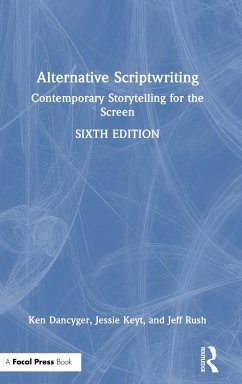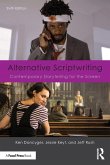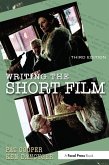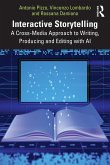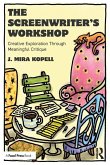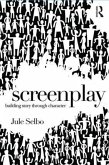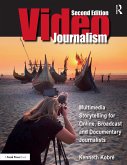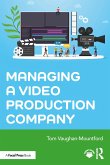Ken Dancyger (Tisch School of the Arts, New York University, NY, US, Jessie Keyt, Jeff Rush (Temple University, Philadelphia, PA, USA)
Alternative Scriptwriting
Contemporary Storytelling for the Screen
Ken Dancyger (Tisch School of the Arts, New York University, NY, US, Jessie Keyt, Jeff Rush (Temple University, Philadelphia, PA, USA)
Alternative Scriptwriting
Contemporary Storytelling for the Screen
- Gebundenes Buch
- Merkliste
- Auf die Merkliste
- Bewerten Bewerten
- Teilen
- Produkt teilen
- Produkterinnerung
- Produkterinnerung
Unlike other screenwriting books, this unique storytelling guide pushes you to break free of tired, formulaic writing by bending or breaking the rules of storytelling as we know them. This new edition dives into all the key aspects of scriptwriting, including structure, genre, character, form, and tone.
Andere Kunden interessierten sich auch für
![Alternative Scriptwriting Alternative Scriptwriting]() Ken DancygerAlternative Scriptwriting35,99 €
Ken DancygerAlternative Scriptwriting35,99 €![Writing the Short Film Writing the Short Film]() Patricia CooperWriting the Short Film43,99 €
Patricia CooperWriting the Short Film43,99 €![Interactive Storytelling Interactive Storytelling]() Antonio PizzoInteractive Storytelling37,99 €
Antonio PizzoInteractive Storytelling37,99 €![The Screenwriter's Workshop The Screenwriter's Workshop]() J. Mira KopellThe Screenwriter's Workshop43,99 €
J. Mira KopellThe Screenwriter's Workshop43,99 €![Screenplay Screenplay]() Jule SelboScreenplay51,99 €
Jule SelboScreenplay51,99 €![Videojournalism Videojournalism]() Kenneth Kobre (USA San Francisco State University)Videojournalism93,99 €
Kenneth Kobre (USA San Francisco State University)Videojournalism93,99 €![Managing a Video Production Company Managing a Video Production Company]() Tom Vaughan-MountfordManaging a Video Production Company38,99 €
Tom Vaughan-MountfordManaging a Video Production Company38,99 €-
-
-
Unlike other screenwriting books, this unique storytelling guide pushes you to break free of tired, formulaic writing by bending or breaking the rules of storytelling as we know them. This new edition dives into all the key aspects of scriptwriting, including structure, genre, character, form, and tone.
Produktdetails
- Produktdetails
- Verlag: Taylor & Francis Ltd
- 6 ed
- Seitenzahl: 444
- Erscheinungstermin: 31. Januar 2023
- Englisch
- Abmessung: 240mm x 161mm x 28mm
- Gewicht: 768g
- ISBN-13: 9781032150550
- ISBN-10: 1032150556
- Artikelnr.: 65612723
- Herstellerkennzeichnung
- Libri GmbH
- Europaallee 1
- 36244 Bad Hersfeld
- gpsr@libri.de
- Verlag: Taylor & Francis Ltd
- 6 ed
- Seitenzahl: 444
- Erscheinungstermin: 31. Januar 2023
- Englisch
- Abmessung: 240mm x 161mm x 28mm
- Gewicht: 768g
- ISBN-13: 9781032150550
- ISBN-10: 1032150556
- Artikelnr.: 65612723
- Herstellerkennzeichnung
- Libri GmbH
- Europaallee 1
- 36244 Bad Hersfeld
- gpsr@libri.de
Ken Dancyger is a Professor of Film and Television at Tisch School of the Arts at New York University as well as the author of numerous books on screenwriting, editing, and production. Jessie Keyt is a writer and Assistant Arts Professor in the Department of Dramatic Writing at Tisch School of the Arts at New York University as well as a story and script consultant for independent filmmakers and production companies in the US, UK, and Europe. Jeff Rush is an Associate Professor at Temple University's Department of Film & Media Arts as well as the author of numerous articles on screenwriting and narrative theory.
Foreword
INTRODUCTION
1. Beyond the Rules
STRUCTURE
2 Structure
3 Critique of Restorative Three-Act Form
4 Counter-Structure
5 The Three-Act Spectrum
6 Strategies for Plot and Character: Surprise, Triangulation, and Subtext
7 Multiple Threaded, Long-Form Episodic Scripts
GENRE
8 Why Genre?
9 Working with Genre
10 Working with Genre II: The Melodrama and the Thriller
11 Working with Genre III: Billy Wilder and Preston Sturges
12 Working Against Genre
13 The Flexibility of Genre
14 Genres of Voice
15 The Nonlinear Film
16 The Fable, a Case Study of Darkness: The Wizard of Oz and Pan's Labyrinth
CHARACTER
17 Reframing the Active/Passive Character Distinction
18 Stretching the Limits of Character Identification
19 Main and Secondary Characters
20 Subtext, Action, and Character
21 Exceptional but Opaque Characters in Flattened Scripts
FORM, TONE, AND THEORY
22 The Subtleties and Implications of Screenplay Form
23 Theatricality on Screen
24 Tone: The Inescapability of Irony
25 Dramatic Voice/Narrative Voice
26 Writing the Narrative Voice
27 Regionalism vs Commercialism: Kelly Reichardt, Eugene Martin, and Kathryn Bigelow
28 Adaptations from Literature
29 Rewriting
CONCLUSION
30 Personal Scriptwriting: The Edge
31 Personal Scriptwriting: The Short Film
INTRODUCTION
1. Beyond the Rules
STRUCTURE
2 Structure
3 Critique of Restorative Three-Act Form
4 Counter-Structure
5 The Three-Act Spectrum
6 Strategies for Plot and Character: Surprise, Triangulation, and Subtext
7 Multiple Threaded, Long-Form Episodic Scripts
GENRE
8 Why Genre?
9 Working with Genre
10 Working with Genre II: The Melodrama and the Thriller
11 Working with Genre III: Billy Wilder and Preston Sturges
12 Working Against Genre
13 The Flexibility of Genre
14 Genres of Voice
15 The Nonlinear Film
16 The Fable, a Case Study of Darkness: The Wizard of Oz and Pan's Labyrinth
CHARACTER
17 Reframing the Active/Passive Character Distinction
18 Stretching the Limits of Character Identification
19 Main and Secondary Characters
20 Subtext, Action, and Character
21 Exceptional but Opaque Characters in Flattened Scripts
FORM, TONE, AND THEORY
22 The Subtleties and Implications of Screenplay Form
23 Theatricality on Screen
24 Tone: The Inescapability of Irony
25 Dramatic Voice/Narrative Voice
26 Writing the Narrative Voice
27 Regionalism vs Commercialism: Kelly Reichardt, Eugene Martin, and Kathryn Bigelow
28 Adaptations from Literature
29 Rewriting
CONCLUSION
30 Personal Scriptwriting: The Edge
31 Personal Scriptwriting: The Short Film
Foreword
INTRODUCTION
1. Beyond the Rules
STRUCTURE
2 Structure
3 Critique of Restorative Three-Act Form
4 Counter-Structure
5 The Three-Act Spectrum
6 Strategies for Plot and Character: Surprise, Triangulation, and Subtext
7 Multiple Threaded, Long-Form Episodic Scripts
GENRE
8 Why Genre?
9 Working with Genre
10 Working with Genre II: The Melodrama and the Thriller
11 Working with Genre III: Billy Wilder and Preston Sturges
12 Working Against Genre
13 The Flexibility of Genre
14 Genres of Voice
15 The Nonlinear Film
16 The Fable, a Case Study of Darkness: The Wizard of Oz and Pan's Labyrinth
CHARACTER
17 Reframing the Active/Passive Character Distinction
18 Stretching the Limits of Character Identification
19 Main and Secondary Characters
20 Subtext, Action, and Character
21 Exceptional but Opaque Characters in Flattened Scripts
FORM, TONE, AND THEORY
22 The Subtleties and Implications of Screenplay Form
23 Theatricality on Screen
24 Tone: The Inescapability of Irony
25 Dramatic Voice/Narrative Voice
26 Writing the Narrative Voice
27 Regionalism vs Commercialism: Kelly Reichardt, Eugene Martin, and Kathryn Bigelow
28 Adaptations from Literature
29 Rewriting
CONCLUSION
30 Personal Scriptwriting: The Edge
31 Personal Scriptwriting: The Short Film
INTRODUCTION
1. Beyond the Rules
STRUCTURE
2 Structure
3 Critique of Restorative Three-Act Form
4 Counter-Structure
5 The Three-Act Spectrum
6 Strategies for Plot and Character: Surprise, Triangulation, and Subtext
7 Multiple Threaded, Long-Form Episodic Scripts
GENRE
8 Why Genre?
9 Working with Genre
10 Working with Genre II: The Melodrama and the Thriller
11 Working with Genre III: Billy Wilder and Preston Sturges
12 Working Against Genre
13 The Flexibility of Genre
14 Genres of Voice
15 The Nonlinear Film
16 The Fable, a Case Study of Darkness: The Wizard of Oz and Pan's Labyrinth
CHARACTER
17 Reframing the Active/Passive Character Distinction
18 Stretching the Limits of Character Identification
19 Main and Secondary Characters
20 Subtext, Action, and Character
21 Exceptional but Opaque Characters in Flattened Scripts
FORM, TONE, AND THEORY
22 The Subtleties and Implications of Screenplay Form
23 Theatricality on Screen
24 Tone: The Inescapability of Irony
25 Dramatic Voice/Narrative Voice
26 Writing the Narrative Voice
27 Regionalism vs Commercialism: Kelly Reichardt, Eugene Martin, and Kathryn Bigelow
28 Adaptations from Literature
29 Rewriting
CONCLUSION
30 Personal Scriptwriting: The Edge
31 Personal Scriptwriting: The Short Film

